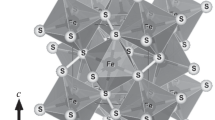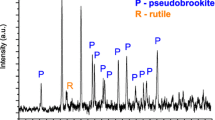Abstract
Some manganese oxides are considered hyperactive under microwave irradiation because of their extremely high heating rates in air. In order to further understand this hyperactivity, thermodynamic calculations, thermogravimetric analysis and both real and imaginary permittivity determinations were performed for hausmannite (Mn3O4) as a function of temperature in an air atmosphere. The thermodynamic results demonstrated reasonable agreement with the thermogravimetric analysis data. A comparison of the derivative thermogravimetric analysis data with the derivative of both the real and the imaginary permittivities confirmed that the extremely high values of the permittivities were due to the conversion of the hausmannite to bixbyite (Mn2O3). The microwave hyperactivity of the manganese oxides in air is explained in terms of the high permittivities of bixbyite.







Similar content being viewed by others
References
Grundy AN, Hallstedt B, Gauckler LJ. Assessment of the Mn-O system. J Phase Equilib. 2003;24:21–39.
Gonzalez C, Gutierrez JI, Gonzalez-Velasco JR, Cid A, Arranz A, Arranz JF. Application of differential scanning calorimetry to the reduction of several manganese oxides. Thermal Anal. 1998;52:985–9.
Hed AZ, Tannhauser DS. Contribution to tlie Mn-0 phase diagram at high temperature. J Electrochem Soc. 1967;114:314–8.
Hahn WC, Muan A. The System Mn-O. Studies in the system Mn–O: the Mn203–Mn304 and Mn304–MnO equilibria. Am J Sci. 1960;258:66–78.
Driessens FCM. Place and valence of the cations in Mn3O4 and some related manganates. Inorg Chim Acta. 1967;1(1):193–201.
Schmier A, Sterr G. Contribution to the knowledge of the hausmannite phase. Z Anorg Allg Chem. 1966;346(3–4):181–7.
Keller M, Dieckmann R. Defect structure and transport properties of manganese oxides: (II) the nonstoichiometry of hausmannite (Mn3–dO4). Ber Bunsenges Phys Chem. 1985;89(10):1095–104.
Ford JD, Pei DCT. High temperature chemical processing via microwave absorption. J Microw Power. 1967;2(2):61–4.
Debye P. Polar molecules. New York, NY: Dover Publications, Inc.; 1929. p. 97.
A. Roine, Outokumpu HSC Chemistry® for Windows: Chemical Reaction and Equilibrium Software with Extensive Thermochemical Database, Version 5.1, October 31, 2002.
Hutcheon RM, De Jong MS, Adams FP. A system for rapid measurement of RF and microwave properties up to 1400°C. J Microw Power Electromagn Energy. 1992;27(2):87–92.
Acknowledgements
The authors would like to thank the Natural Sciences and Engineering Research Council of Canada (NSERC) for supporting this research. Also the authors would like to thank R. M. Hutcheon and J. Mouris of Microwave Properties North for the permittivity measurements and F. Gibbs of the Brockhauser Materials Institute at McMaster University for performing the TG analysis.
Author information
Authors and Affiliations
Corresponding author
Rights and permissions
About this article
Cite this article
Amankwah, R.K., Pickles, C.A. Thermodynamic, thermogravimetric and permittivity studies of hausmannite (Mn3O4) in air. J Therm Anal Calorim 98, 849–853 (2009). https://doi.org/10.1007/s10973-009-0273-3
Received:
Accepted:
Published:
Issue Date:
DOI: https://doi.org/10.1007/s10973-009-0273-3




